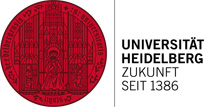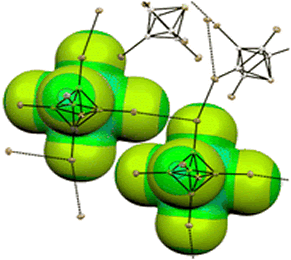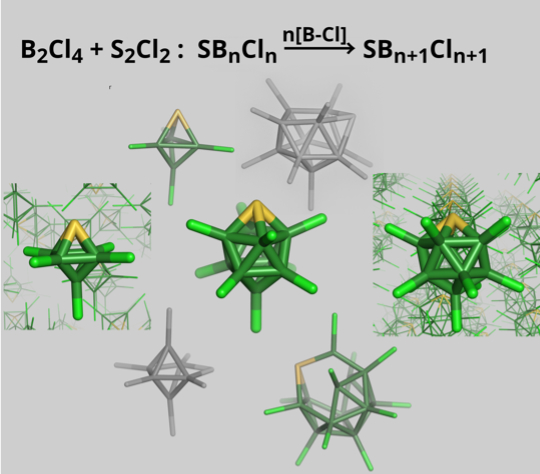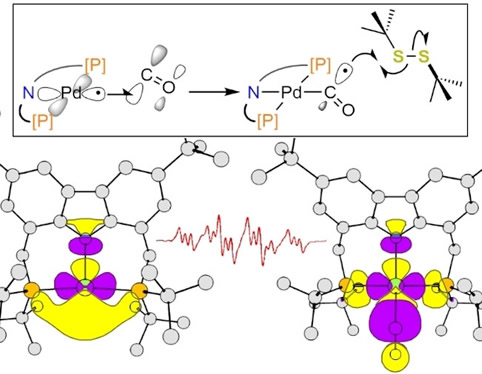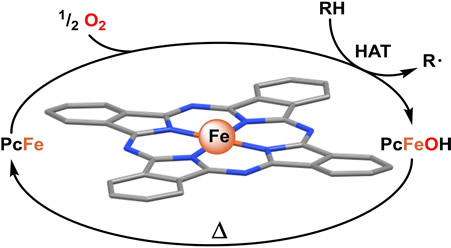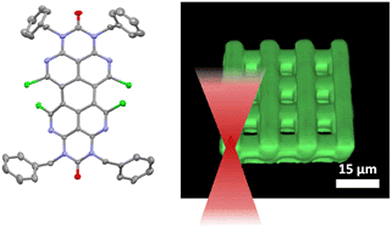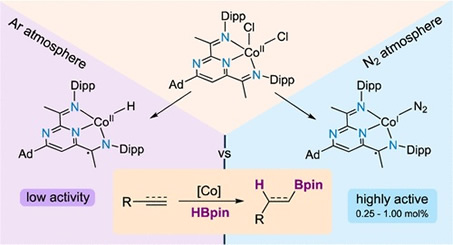Publication
Preparing Your Publication
At first, think about which structures are to be included in your manuscript and which of those structures are essential to your manuscript. As a rule of thumb, structures that are essential to your manuscript should be discussed and depicted in the main article. Less important structures are commonly moved to the Supporting Information. Ultimately, however, an illustration (along with a figure caption) should be created for each structure. It is good practice to show the ADPs (anisotropic displacement parameters, i.e. the ellipsoids) in your figures. Since all shortcomings and error are collected in the ADPs, the reader gets an impression of the qualitiy of your stucture, simply by looking at the ADPs. A figure without ADPs is not sufficient.
In the caption, the isovalue that was used to draw the ellipsoids (e.g. 50% probability level) has to be provided. An example of a caption: ORTEP plot of the molecular strucutre of 5 (anisotropic displacement ellipsoids drawn at 50% probability level, disordered ethyl groups and hydrogen atoms ommited for clarity). Selected bond lengths (Å) and angles (°): Co1-P1 1.2345(12), N1-Co1-P1 92.34(1).
Summarize all the crystallographic data in a table (download template). Note: Please state our internal code of each structure (e.g. ga_fb101) in the field "CCDC Number" of your table..
Before Submitting Your Manuscript
Once you have created a complete draft of your manuscript (including figures and table of your structures), we can proceed to finalize the so-called .cif files (one per structure). We will then send these .cif files to the Cambridge Structural Database (CSD). Within a few days, the structures will be added to the database. Subsequently, we will receive the CCDC numbers - we are adding these numbers to your table by replacing the internal codes (vide supra). During submission, you (or your supervisor) will not only need these numbers, but also a up-to-date checkcif.pdf, which will be send to you (usually along with a few additional suggestions and corrections). We will also write a short text for the Experimental Section of the manuscript or the Supporting Information.
After Submission
Please inform the X-ray lab, in case a reviewer expresses a concern or asks questions about the structures. We are happy to assist you and we help to phrase an answer (or a suggestion for an answer). Once accepted, your publication will be added to the following list.
Publications with Contribution of the X-Ray Laboratory
- R. Eichelmann, K. Bender, J. A. Guenther, L. A. Ziegenhagen, J. Ballmann, L. H. Gade, “Bay-Aminated Octaazaperopyrenedioxides (OAPPDOs) as Precursors for Diazepine and Diazepinone Derivatives”, Org. Lett. 2025, 27, 1396-1401.

- W. Keller, J. Ballmann, J. Fanfrlík, D. Hnyk, “The synthesis and structural aspects of the perbromo-functionalised thiaboranes closo-SBnBrn (n = 5, 9, 11): the solid-state structure of the octahedral closo-SB5Br5, governed by strong dihalogen contacts”, Chem. Commun. 2025, 61, 2528-2531.

- L. K. Paschai Darian, J. Ballman, L. H. Gade, “T-shaped 14 Electron Rhodium Complexes: Potential Active Species in C-H
Activation”, Angew. Chem. Int. Ed. 2024, 63, e202416814.
 German Edition: Angew. Chem. 2024, 136, e202416814.
German Edition: Angew. Chem. 2024, 136, e202416814.
- F. Braun, T. Bruckhoff, J. Ott, J. Ballmann, L. H. Gade, “Carbon-Carbon Bond activation at Chromium(I): An 11-Electron Complex Cleaving Dialkynes”, Angew. Chem. Int. Ed. 2024, 63, e202418646.
 German Edition: Angew. Chem. 2024, 136, e202406751.
German Edition: Angew. Chem. 2024, 136, e202406751.
- W. Keller, F. Lissner, J. Ballmann, J. Fanfrlík, D. Hnyk, T. Schleid, “A Direct Route to closo-SBnCln Thiaboranes from Simple Electron-Precise Synthons: The Different Role of Chalcogen Bonding in SB5Cl5 and SB11Cl11 Crystals”, Angew. Chem. Int. Ed. 2024, 63, e202406751.
 German Edition: Angew. Chem. 2024, 136, e202406751.
German Edition: Angew. Chem. 2024, 136, e202406751.
- T. Bruckhoff, J. Ballmann, L. H. Gade, “Radicalizing CO by Mononuclear Palladium(I)”, Angew. Chem. Int. Ed. 2024, 63, e202320064.
 German Edition: Angew. Chem. 2024, 136, e202320064.
German Edition: Angew. Chem. 2024, 136, e202320064. 
- M. Hertzog, R. Eichelmann, P. Jeudy, T. Wesp, S. Settele, F. L. Sebastian, A. Mischok, F. Le Roux, F. Tenopala Carmona, J. Ballmann, M. C. Gather, L. H. Gade, J. Zaumseil, “Bay-Substituted Octaazaperopyrenedioxides as Solid-State Emitters for Strong Light-Matter Coupling”,J. Mater. Chem. C. 2024, 12, 2745-2755.

- R. Eichelmann, P. Jeudy, L. Schneider, J. Zerhoch, P. R. Mayer, J. Ballmann, F. Deschler, L. H. Gade, “Chiral Bay-alkynylated Tetraazaperylenes: Photophysics and Chiroptical Properties”,Org. Lett. 2024, 26, 1172-1177.

- C. Iwanov, M. P. Hopp, D. Lorenz, J. Ballmann, M. Enders, “Dioxygen Activation and Reduction by a Soluble Iron Phthalocyanine”,Chem. Eur. J. 2023, 29, e202302761.

- R. Eichelmann, D. Rippel, J. Ballmann, L. H. Gade, “Zipping up tetraazaperylene: synthesis of tetraazacoronenes via double coupling in the bay positions”, Chem. Commun. 2023, 59, 12136-12139.

- R. Eichelmann, J. Ballmann, L. H. Gade, “Tetraazacoronenes and Their Dimers, Trimers and Tetramers”, Angew. Chem. Int. Ed. 2023, 62, e202309198.
 German Edition: Angew. Chem. 2023, 135, e202309198.
German Edition: Angew. Chem. 2023, 135, e202309198.
- R. Eichelmann, J. Monti, L.-Y. Hsu, F. Kröger, J. Ballmann, E. Blasco, L. H. Gade, “Two-photon microprinting of 3D emissive structures using tetraazaperylene-derived fluorophores”, Mol. Syst. Des. Eng. 2023, Advance Article.

- L. E. Hertwig, T. Bender, F. J. Becker, P. Jäger, S. Demeshko, S. J. Gross, J. Ballmann, D.-A. Roșca, “Iron-Catalyzed Synthesis of Conformationally Restricted Bicyclic N-Heterocycles via [2+2]-Cycloaddition: Exploring Ring Expansion─Mechanistic Insights and Challenges”, ACS Catal. 2023, 13, 6416-6429.

- J. S. Doll, M. L. Heldner, M. Scherr, J. Ballmann, D.-A. Roşca, “The Atmosphere Matters: The Effect of “Inert” Gas on the Catalytic Outcomes in Cobalt-Mediated Alkyne and Olefin Hydroboration”, ACS Catal. 2023, 13, 8770-8782.

- W. Keller, J. Ballmann, M. B. Sárosi, J. Fanfrlík, D. Hnyk, “The Telluraboranes closo-TeB5Cl5 and closo-TeB11Cl11 with Exceptionally Long Body Diagonals: Synthetic and Bonding Motifs for Innovative Octahedral and Icosahedral Geometries ”, Angew. Chem. Int. Ed. 2023, 62, e202219018.
 German Edition: Angew. Chem. 2023, 135, e202219018.
German Edition: Angew. Chem. 2023, 135, e202219018.
